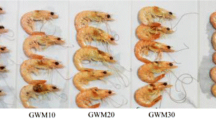Abstract
The performance of an artificial practical diet, kappacarrageenan microbound diet (C-MBD) was assessed on Penaeus monodon larvae at the SEAFDEC Broodstock and Maturation Experimental Laboratory in March 1986. Shrimps were reared from zoea1 to post-larvae1 using five dietary treatments: (a) natural food — Chaetoceros calicitrans and Artemia salina (b) C-MBD; (c) combination of natural food and C-MBD; (d) commercial diet (microencapsulated, MED); (e) combination of natural food and commercial diet. Results showed slow development with larvae fed the commercial diet. Feeding with C-MBD in combination with natural food resulted in the highest % survival among treatments (69.6), but this was not significantly different (P>0.05) from those obtained with larvae fed natural food alone, C-MBD alone or their combination. While mean values for survival of larvae fed the commercial diet, either alone or in combination, was significantly lower (p<0.05) than all other treatments, their mean growth indices were comparable with larvae fed C-MBD alone or in combination. The low levels of protein, lipid and essentially fatty acids (which are considered important nutrients during larval development) contained in the commercial diet may well justify the results on metamorphosis, survival and growth of the larvae fed this diet. The good performance of C-MBD in this experiment suggests that this kind of diet can be used as partial or total replacement to the traditional algal food.
Similar content being viewed by others
Literature cited
Bligh, E. G., Dyer, W. J. (1959). A rapid method of total lipid extraction and purification. Can. J. Biochem. Physiol. 37 911–917
Castell, J. D., Cowey, J. F. (1976). Dietary lipid requirements of adult lobsters, Homarus americanus. J. Nutr. 106: 1159–1165
Claybrook, D. L. (1976). Biosynthesis of amino acids from 3-(14-C) pyruvate in the fiddler crab, Uca pugilator. Comp. Biochem. Physiol. 54B: 63–68
Cowey, C. B., Forster, J. R. M. (1971). The essentical amino acid requirements of the prawn, Palaemon serratus. The growth of prawns on diets containing proteins of different amino acid composition. Mar. Biol. 10: 77–81
Deshimaru, O., Kuroki, K. (1975). studies on a purified diet for prawn. IV. Evaluation of protein, free amino acids and their mixture as nitrogen source. Bull. Japan. Soc. scient. Fish. 41: 101–103
Gallagher, M., Brown, W. D. (1975). Composition of San Fransisco Bay brineshrimp (Artemia salina). Agric. Fd. Chem. 23: 630–633
Gomez, K. A., Gomez, A. A. (1976). Statistical procedures for agricultural research with emphasis on rice. The International Rice Research Institute, Los Banos, Laguna, Philippines
Guary, J. C., Kayama, M., Murakami, Y., Ceccaldi, H. J. (1976). The effects of a fat-free diet and compounded diets supplemented with various oils on moult, growth and fatty acid composition of the prawn, Penaeus japonicus Bate. Aquaculture, Amsterdam 7: 245–254
Hirata, H. (1975). An introduction to the rearing methods of prawn, Penaeus japonicus Bate in Japan. Mem. Fac. Fish. Kagoshima Univ. 24: 7–12
Jones, D. A., Kanazawa, A., Abdel-Rahman, S. (1979). Studies on the presentation of artificial diets for rearing larvae of Penaeus japonicus Bate. Aquaculture, Amsterdam 17: 33–43
Kanazawa, A., Shimaya, M., Kawasaki, M., Kashiwada, K. (1970). Nutritional requirements of prawn-I. Feeding on diet. Bull. Japan. Soc. scient. Fish. 36: 949–954
Kanazawa, A., Teshima, S., Endo, H., Kayama, M. (1978). Effects of eicosapentaenoic acid on growth and fatty acid composition of the prawn, Penaeus japonicus. Mem. Fac. Fish. Kagoshima Univ. 27: 35–40
Kanazawa, A., Teshima, S., Sasada, H., Abdel-Rahman, S. (1982). Rearing of the prawn larvae with microparticulate diets. Bull. Japan. Soc. scient. Fish. 48: 195–199
Kanazawa, A., Teshima, S., Tokiwa, S. (1977a) Nutritional requirements of prawn-VII. Effects of dietary lipid on growth. Bull. Japan. Soc. scient. Fish. 43: 849–856
Kanazawa, A., Tokiwa, S., Kayama, M., Hirata, M., (1977b). Essential fatty acids in the diet of prawn-I. Effects of linoleic and linolenic acids on growth. Bull. Japan. Soc. scient. Fish. 43: 1111–1114
Lasser, G. W., Allen, W. V. (1976). The essential amino acid requirements of the Dungeness crab Cancer magister. Aquaculture, Amsterdam 7: 235–244
Levine, D. M., Sulkin, S. D., Van Heukelem, L. (1983). The design and development of microencapsulated diets for the study of nutritional requirements of brachyuran crab larvae. In: Berg, C. J., Jr (ed.) Culture of marine invertebrates: selected readings. Hutchinson Ross Publishing Co., Stronsburg, Pennsylvania, p. 193–203
Metcalfe, L. O., Schmitz, A. A., Pelka, J. R. (1966). Rapid preparation of fatty acid esters from lipids in gas chromatography. Analyt. Chem. 38: 514
Meyers, S. P., Butler, D. P., Sivine, G. F. (1985). Encapsulation: a new approach to larval feeding. Publication of the Dept. of Food Science, Louisiana State Univ., Baton Rouge, Louisiana and Stanford Research Institute. Irvin, California
Miyajima, L. S. Broderick, G. A., Reimer, R. P. (1975). Identification of the essential amino acids of the freshwater shrimp, Macrobrachium ohiorie. Proc. A. Wld Meet. Wld Maricult. Soc. 6: 699–704
Moller, T. H., Jones, D. A., Gabbott, P. A. (1979). Further developments in the microencapsulation of diets for marine animals used in aquaculture. In: Kondo, T. (ed.) Proc. 3rd int. Symp. Microencapsulation, Tokyo. Techno Inc., Tokyo, p. 223–229
Shewbart, K. L., Mies, W. L., Ludwig, P. P. (1972). Identification and quantitative analysis of the amino acids present in protein of the brown shrimp, Penaeus aztecus. Mar. Biol. 16: 64–67
Teshima, S., Kanazawa, A., Sakamoto, M. (1982). Microparticulate diets for the larvae of aquatic animals. Min. Rev. Data File Fish. Res. 2: 67–86
Villegas, C. T., Kanazawa, A. (1980). Rearing of the larval stages of prawn, P. japonicus, Bate using artificial diet. Mem. Kagoshima Univ. Res. Cent. S. Pac. 1: 43–49
Author information
Authors and Affiliations
Additional information
Communicated by M. Anraku, Tokyo
Rights and permissions
About this article
Cite this article
Bautista, M.N., Millamena, O.M. & Kanazawa, A. Use of kappa-carrageenan microbound diet (C-MBD) as feed for Penaeus monodon larvae. Mar. Biol. 103, 169–173 (1989). https://doi.org/10.1007/BF00543344
Accepted:
Issue Date:
DOI: https://doi.org/10.1007/BF00543344




